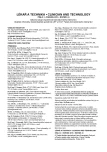Indikace k operační léčbě popálenin při využití metody laserdoppler imaging
Authors:
Jiří Štětinský 1; Hana Klosová 1; Zdenka Němečková Crkvenjaš 1; Hana Kolářová 2; Iveta Bryjová 3; Stanislav Hledík 4; Dana Šalounová 5
Authors‘ workplace:
Popáleninové centrum, Fakultní nemocnice Ostrava, Česká republika
1; Ústav lékařské biofyziky, Lékařská fakulta University Palackého, Olomouc, Česká republika
2; Katedra kybernetiky a biomedicínského inženýrství, FEI, VŠB-TU, Ostrava, Česká republika
3; Ústav biofyziky, Slezská Universita v Opavě, Česká republika
4; Katedra matematických metod v ekonomice, FEI, VŠB-TU, Ostrava, Česká republika
5
Published in:
Lékař a technika - Clinician and Technology No. 2, 2013, 43, 23-27
Category:
Original research
Overview
The clinical assessment of depth of burns misdiagnosed in up to 35% of cases, especially in the early stages of thermal trauma to the 5th postoperative day. The correct determination of the depth of burns is crucial for planning the adequate therapeutic approach, ie, conservative or surgical treatment of burn wounds. Four basic grades of burn depth are distinguished cliniccaly. Grade I, IIa, IIb can be treated conservatively. Grade III and IV, but also some deeper grade IIb should be operated. Burns IIb cause the most diagnostic difficulties and the indications for surgical treatment is determind by depth of corium affection, which correlates with blood circulation in the dermis and the length of healing. Clinically, it is very difficult to estimate the depth of the affected dermis. LDI, laserdoppler imaging is the one of the ways to objectively and non-invasively assess the depth of the burns.
LDI is an imaging technique that uses a laser radiation and the Doppler effect to detect blood flow in the skin capillaries. When thermal trauma directly damages the walls of capillaries, the subsequent tissue necrosis occures. Specificity and sensitivity of LDI in determining of the burn depth states 95% [1].
In our work, we propose a diagnostic algorithm for evaluation of capillary perfusion measured by LDI. Testing can be done up to 9th posttraumatic day, taking into account the current day after the accident.
LDI is a suitable tool for the indication of surgical treatment. The following procedures should facilitate this process.
Keywords:
Laser Doppler Imaging (LDI), capillary perfusion, perfusion unit(PU), posttraumatic day
Sources
[1] Scott, John R., Stuart, B. 7 Surgical management of burns. Baillire's Clinical Anaesthesiology, 1997, vol. 11, no. 3, p. 473-495.
[2] Hemington-Gorse, S.J. A comparison of laser Doppler imaging with other measurement techniques to assess burn depth. Journal of wound care, 2005, vol.14, no. 4, p. 151-153.
[3] Watkins, D., Holloway Ga. An instrument to measure cutaneous blood flow using the Doppler shift of laser light. IEEE transactions on biomedical engineering. Bio-medical Engineering Group, 1978, vol. 25, p. 28-33.
[4] Watt, A.M.I., Tyler, M.P.H. Burn depth and its histological measurement. Burns, 2001, vol.27, no. 2.
[5] Atiles, L., Mileski, W. Early assesment of pediatric burn wounds by laser Doppler flowmetry. J Burn Care Rehabil, 1995, vol.16, no. 16, p.596-601.
[6] Cubison, Tania, C.S. Evidence for the link between healing time and the development of hypertrophic scars (HTS) in paediatric burns due to scald injury. Burns. 2006, vol.32, no.8, p.992-999.
[7] Klein, Matthew,B. Hospital Costs Associated With Pediatric Burn Injury. Journal of Burn Care,2008,vol.29,no.4,p.632-637.
[8] Jeng, J.C., Bridgeman, A. Laser Doppler imaging determines need for excision and grafting in advance of clinical judgment: a prospective blinded trial, Burns, 2003, vol.29, no.7, p.665-670.
[9] Mill, J., Cuttle L. Laser Doppler imaging in a paediatric burns population. Burns, 2009, vol.35, no.6, p.824-831.
[10] La Hei, E.R., Holland A.J.. Laser Doppler Imaging of paediatric burns: Burn wound outcome can be predicted independent of clinical examination. Burns. 2006, vol.32, no.5, p.550-553.
[11] Holland, A.J., Martin H.C. Laser Doppler imaging prediction of burn wound outcome in children. Burns, 2002, vol.28, no.1, p.11-17.
[12] Droog, E.J, Steenbergen W. Measurement of depth of burns by laser Doppler perfusion imaging. Burns, 2002, vol.28, no.1, p.561-568.
[13] Niazi, ZBM., Essex, TJH. New laser Doppler scanner, a valuable adjunct in burn depth assessment. Burns, 1993, vol. 19, p. 485-9.
[14] Riordan, Colin L.Noncontact Laser Doppler Imaging in Burn Depth Analysis of the Extremities. Journal of Burn Care, 2003, vol.24, no.4, p.177-186.
[15] Cho, J.K., Moon D.J. Relationship between healing time and mean perfusion units of laser Doppler imaging (LDI) in pediatric burns. Burns, 2009, vol.35, no.6, p.818-823.
[16] Lawrence, H.C., Ward, D.The Impact of Laser Doppler Imaging on Time to Grafting Decisions in Pediatric Burns. Journal of Burn Care, 2010, vol.31, no.2, p.328-332.
[17] Brown, RFR., Rice, P. RICE. The use of laser Doppler imaging as an aid in clinical management decision making in the treatment of vesicant burns. Burns, 1998, vol.24, no.8, p.692-698.
[18] Sjoberg, F., Danielsson, P. Utility of an intervention scoring system in documenting effects of changes in burn treatment. Burns, 2000, vol.26, no.6, p.553-9.
[19] Kloppenberg W.H., Beerthuizen, G.I.J.M. Perfusion of burn wounds assessed by Laser Doppler Imaging is related to burn depth and healing time. Burns, 2001, vol. 27, p. 359–363.
[20] Monstrey, S.M., Hoeksema, H. Reprint of: Burn wound healing time assessed by laser Doppler imaging. Part 2. Burns, 2012, vol.38, no.2, p.195-202.
[21] Hoeksema, H., Van De Skipe, K. Accuracy of early burn depth assessment by laser Doppler imaging on different days post burn. Burns, 2009, vol. 1, no.35, p. 36-45.
Labels
BiomedicineArticle was published in
The Clinician and Technology Journal

2013 Issue 2
Most read in this issue
- Artefakty spôsobené pacientom pri zobrazovaní magnetickou rezonanciou
- Hodnocení revaskularizace dolních končetin pomocí termografických měření a metodika
- Indikace k operační léčbě popálenin při využití metody laserdoppler imaging
- WEARABLE ARTIFICIAL KIDNEY – EVOLUTION OF ITS CONCEPTS AND CURRENT STATE-OF-THE-ART
